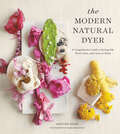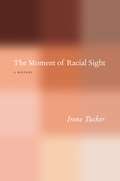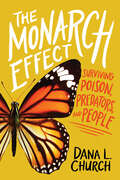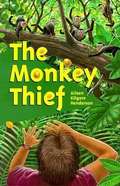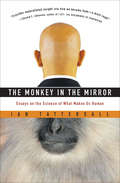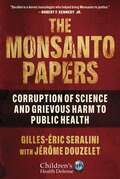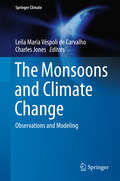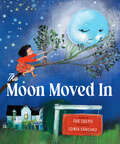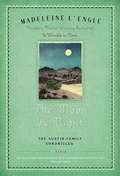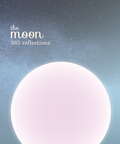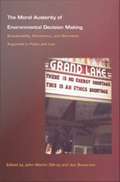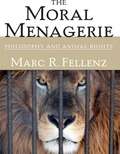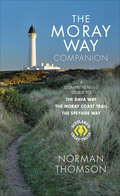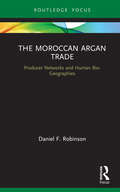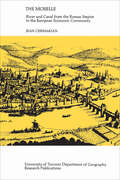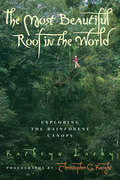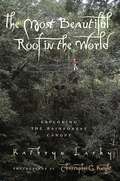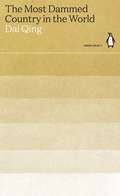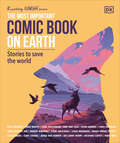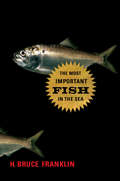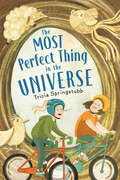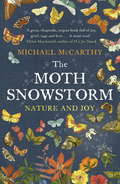- Table View
- List View
The Modern Natural Dyer: A Comprehensive Guide to Dyeing Silk, Wool, Linen, and Cotton at Home
by Kristine Vejar“Kristine’s book breaks down natural dyeing from both a scientific and creative perspective, making the process feel as approachable as it is beautiful.” —Design*SpongeThousands of natural materials can produce glorious color—the insect cochineal produces pink, maroon, and purple, and more than 500 species of plants produce indigo blue. In The Modern Natural Dyer expert Kristine Vejar shares the most user-friendly techniques for dyeing yarn, fabric, and finished goods at home with foraged and garden-raised dyestuffs as well as with convenient natural dye extracts. Demystifying the “magic,” Vejar explains in explicit, easy-to-follow detail how to produce consistent, long-lasting color. With stunning photography of the dyes themselves, the dyeing process, and twenty projects for home and wardrobe (some to knit, some to sew, and some just a matter of submerging a finished piece in a prepared bath), The Modern Natural Dyer is a complete resource for aspiring and experienced dye artisans.“A terrific primer for anyone new to the technique. Kristine walks you through the ins and outs of the process, from defining what scouring and mordanting mean to helping you learn how best to achieve desired colors.” —DIY Network“Vejar’s lovely book is very sophisticated and detailed.” —Library Journal (starred review)“Absolutely stunning . . . The projects range from dyeing pre-made items like a slip, silk scarf or tote bag to dyeing yarn to knit a hat, shawl or cardigan . . . exceeded all my high expectations.” —Make Something
The Moment of Racial Sight: A History
by Irene TuckerThe Moment of Racial Sight overturns the most familiar form of racial analysis in contemporary culture: the idea that race is constructed, that it operates by attaching visible marks of difference to arbitrary meanings and associations. Searching for the history of the constructed racial sign, Irene Tucker argues that if people instantly perceive racial differences despite knowing better, then the underlying function of race is to produce this immediate knowledge. Racial perception, then, is not just a mark of acculturation, but a part of how people know one another. Tucker begins her investigation in the Enlightenment, at the moment when skin first came to be used as the primary mark of racial difference. Through Kant and his writing on the relation of philosophy and medicine, she describes how racialized skin was created as a mechanism to enable us to perceive the likeness of individuals in a moment. From there, Tucker tells the story of instantaneous racial seeing across centuries—from the fictive bodies described but not seen in Wilkie Collins’s realism to the medium of common public opinion in John Stuart Mill, from the invention of the notion of a constructed racial sign in Darwin’s late work to the institutionalizing of racial sight on display in the HBO series The Wire. Rich with perceptive readings of unexpected texts, this ambitious book is an important intervention in the study of race.
The Monarch Effect: Surviving Poison, Predators, and People (Scholastic Focus)
by Dana L. ChurchA not-so-typical look at the mysteries of the monarch butterflyScholastic Focus is the premier home of thoroughly researched, beautifully written, and thoughtfully designed works of narrative nonfiction aimed at middle-grade and young adult readers. These books help readers learn about the world in which they live and develop their critical thinking skills so that they may become dynamic citizens who are able to analyze and understand our past, participate in essential discussions about our present, and work to grow and build our future.With their stunning black-and-orange wings, monarch butterflies are one of the most recognizable insects on the planet. But despite their delicate beauty, these creatures are warriors. The moment they hatch, they're fighting for their lives. Everything is the enemy: from the very leaf they live on to the humans and animals around them to nature itself. How does such a tiny egg survive to become a butterfly? And even after emerging from the cocoon, unimaginable danger awaits: migration.Every year, monarchs take flight, making one of the greatest migrations in the world. However, for a long time, their destination was unknown within the scientific community. Through the research of scientists in Canada and the United States and the support and efforts of ordinary people as well as Indigenous knowledge in Mexico, that mystery was finally solved. But to do so would involve years of searching across three countries and encounters with feuding scientists, the consequences of colonialism, and life-and-death stakes. Weaving together the untold story of survival, scientific discoveries, and the relationship between humans and butterflies, The Monarch Effect explores how one small insect can have an incredible impact on the entire planet.
The Monkey Thief
by Aileen Kilgore HendersonWhile visiting his uncle in a Costa Rican rain forest, Steve meets a monkey which he wants to tame and a smuggler who forces him to some very responsible decisions.
The Monkey in the Mirror: Essays on the Science of What Makes Us Human
by Ian TattersallAn “absorbing” look at how our species evolved, from the curator of human evolution at the American Museum of Natural History (Kirkus Reviews).What makes us so different from those other animals? How did we get this way? How do we know? And what exactly are we? These questions are what make human evolution a subject of general fascination. Ian Tattersall, one of those rare scientists who is also a graceful writer, addresses them in this delightful book.Tattersall leads the reader around the world and into the far reaches of the past, showing what the science of human evolution is up against—from the sparsity of evidence to the pressures of religious fundamentalism. Looking with dispassion and humor at our origins, Tattersall offers a wholly new definition of what it is to be human.“Unparalleled insight.” —Donald C. Johanson, author of Lucy: The Beginnings of Humankind
The Monsanto Papers: Corruption of Science and Grievous Harm to Public Health (Children’s Health Defense)
by Gilles-Éric Seralini Jérôme DouzeletA David and Goliath battle for truth A specialist in GM foods and pesticides, the biologist Gilles-Éric Seralini has studied their toxicity and effects on people's health for many years. In September 2012, for the first time in a major scientific journal (Food and Chemical Toxicology), he published a study showing the effect on the liver and kidneys of two of Monsanto's flagship products: Roundup weedkiller and the GM foods created to absorb it. Images from the study of tumor-ridden rats fed with GM foods and Roundup went viral. The study was a PR disaster for Monsanto. The multinational soon bounced back and did everything in its power to cover up the study—leaning on the publishers to retract the findings. Monsanto began a series of smear campaigns to discredit Seralini and fellow researchers and intimidate their supporters, while pumping out their own collection of fake research findings and testimonies. These practices were met with huge suspicion, but there was no concrete evidence until, in 2017, Monsanto was ordered to publish tens of thousands of confidential documents in a class-action lawsuit presented by thousands of individuals afflicted with serious illnesses from their use of Roundup. The "Monsanto Papers" that were produced subsequently proved the company&’s cynical attempts at a cover-up as well as its fraudulent practices. Gilles-Éric Seralini and Jérôme Douzelet delved into the documents and discovered how, in the pursuit of its own short term economic interests, Monsanto used sophisticated methods of deceit to bypass legislation devised to protect millions of people. Seralini and Douzelet discovered how Monsanto managed to provide phony assessments to conceal the poisons its products contain, thus deceiving the public authorities and the scientific and medical communities.
The Monsoons and Climate Change
by Charles Jones Leila Maria Véspoli CarvalhoThis book presents a global overview examining monsoon variability in South Asia, Australian, South America and North American, as well as a focus on glaciers and monsoon systems. Monsoon systems are important components of the Earth's climate and play fundamental roles in water and energy balances. The variability and changes in the monsoons affect millions of people and the economies of many countries. This book presents the physical mechanisms involved with monsoon systems, including recent modeling advances addressing climate changes and future projections. The Monsoons and Climate Change will be of interest to both graduate students and researchers.
The Moon Moved In
by Sue SoltisTHREE STARRED REVIEWS What would happen if the moon moved in next door? A funny and original story about an unexpected friendship, the essential role of the moon, and our power to connect, even from far away. “Perfectly captures the curiosity and delight of a child’s mind. Adults could learn a thing or two.”—Aaron Becker, author-illustrator of Caldecott Honor–winning picture book JourneyWhen the Moon moves into the long-empty house next door, all the rooms fill up with light—and Stella finally has a friend. But without the Moon in orbit, the world is going topsy-turvy. The tides stop, and the Earth has a new wobble. Stella worries, but the Moon just wants to stay and garden. Can Stella convince the Moon that life on Earth needs the Moon back in orbit? And what will become of her wish for a friend next door?EDUCATIONAL AND HEARTWARMING: This deeply felt story of an unusual friendship also celebrates the Moon’s role in the natural workings of the world. Fun facts about the moon's impact on our planet’s environment, animals, and humans are included at the front and back of the book! PRIORITIZING THE PLANET: Stella realizes that even though she loves having her friend close, the consequences are too significant. She learns to prioritize her planet over herself, supporting Moon in returning to his place in the sky and resuming his role. But she also learns that Moon is never far away! ENGAGEMENT WITH THE WORLD: This clever moon book for kids features a scientifically minded female protagonist who loves the Earth’s smallest creatures, is concerned for everyone’s well-being, and is interested in space. BEAUTIFUL, INSPIRING GIFT: Perfect for future scientists, aspiring astronomers, moon lovers, bug lovers, and budding gardeners—as well as anyone looking for a new friend. Perfect for: Anyone who loves the moon Kids who enjoy science facts and learning about the environment Parents and educators looking for picture books with astronomical or STEM themes Readers interested in stories with strong themes of friendship and social-emotional learning
The Moon by Night (Austin Family Chronicles #2)
by Madeleine L'EngleVicky Austin, almost 15, tells about her family's summer cross-country camping trip. From the Austin series. During this camping trip, Vicky tries to come to terms with her feelings about life, God, boys, and the possibility of starting school in New York City in the fall.
The Moon of the Wild Pigs (Thirteen Moons)
by Jean Craighead GeorgeDescribes animal and plant life in the drought-parched desert during the month of July and how a little wild pig adapts to this environment. Includes image descriptions.
The Moon: 365 reflections
by PyramidThroughout history, legend and myth, the Moon has symbolized immortality and eternity, enlightenment and adventure and has inspired poets, philosophers, astronomers and artists. Reflections upon the Moon from literature, philosophy, science and ancient wisdom are gathered together in this enchanting collection.
The Moral Austerity of Environmental Decision Making: Sustainability, Democracy, and Normative Argument in Policy and Law
by John Martin Gillroy Joe BowersoxIn The Moral Austerity of Environmental Decision Making a group of prominent environmental ethicists, policy analysts, political theorists, and legal experts challenges the dominating influence of market principles and assumptions on the formulation of environmental policy. Emphasizing the concept of sustainability and the centrality of moral deliberation to democracy, they examine the possibilities for a wider variety of moral principles to play an active role in defining "good" environmental decisions. If environmental policy is to be responsible to humanity and to nature in the twenty-first century, they argue, it is imperative that the discourse acknowledge and integrate additional normative assumptions and principles other than those endorsed by the market paradigm. The contributors search for these assumptions and principles in short arguments and debates over the role of science, social justice, instrumental value, and intrinsic value in contemporary environmental policy. In their discussion of moral alternatives to enrich environmental decision making and in their search for a less austere and more robust role for normative discourse in practical policy making, they analyze a series of original case studies that deal with environmental sustainability and natural resources policy including pollution, land use, environmental law, globalism, and public lands. The unique structure of the book--which features the core contributors responding in a discourse format to the central chapters' essays and debates--helps to highlight the role personal and public values play in democratic decision making generally and in the field of environmental politics specifically. Contributors. Joe Bowersox, David Brower, Susan Buck, Celia Campbell-Mohn, John Martin Gillroy, Joel Kassiola, Jan Laitos, William Lowry, Bryan Norton, Robert Paehlke, Barry G. Rabe, Mark Sagoff, Anna K. Schwab, Bob Pepperman Taylor, Jonathan Wiener
The Moral Challenge of Dangerous Climate Change
by Darrel MoellendorfThis book examines the threat that climate change poses to the projects of poverty eradication, sustainable development, and biodiversity preservation. It offers a careful discussion of the values that support these projects and a critical evaluation of the normative bases of climate change policy. This book regards climate change policy as a public problem that normative philosophy can shed light on. It assumes that the development of policy should be based on values regarding what is important to respect, preserve, and protect. What sort of climate change policy do we owe the poor of the world who are particularly vulnerable to climate change? Why should our generation take on the burden of mitigating climate change that is caused, in no small part, by emissions from people now dead? What value is lost when natural species go extinct, as they may well do en masse because of climate change? This book presents a broad and inclusive discussion of climate change policy, relevant to those with interests in public policy, development studies, environmental studies, political theory, and moral and political philosophy.
The Moral Menagerie: Philosophy and Animal Rights
by Marc R. FellenzThe Moral Menagerie offers a broad philosophical analysis of the recent debate over animal rights. Marc Fellenz locates the debate in its historical and social contexts, traces its roots in the history of Western philosophy, and analyzes the most important arguments that have been offered on both sides. Fellenz argues that the debate has been philosophically valuable for focusing attention on fundamental problems in ethics and other areas of philosophy, and for raising issues of concern to both Anglo-American and continental thinkers. More provocatively, he also argues that the form the debate often takes--attempting to extend our traditional human-centered moral categories to cover other animals--is ultimately inadequate. Making use of the critical perspectives found in environmentalism, feminism and post-modernism, he concludes that taking animals seriously requires a more radical reassessment our moral framework than the concept of 'animal rights' implies.
The Moray Way Companion: A Comprehensive Guide to The Dava Way, The Moray Coast Trail and the Speyside Way
by Norman ThomsonThe Moray Way consists of all or part of three previously existing routes: the Moray Coast Trail, the Speyside Way and the Dava Way. Together they cover a huge and varied range of landscapes.This book is the ideal guide to much of what this beautiful and richly historical part of Scotland has to offer. The largest town, Forres, is an ancient royal burgh. Between it and the next biggest town of Lossiemouth lie the coastal villages of Findhorn, Burghead and Hopeman, connected by some of Scotland’s finest coastal scenery and beaches. Eastwards, beyond intact remains of second world war defences, lie Garmouth and Fochabers, the former, many centuries ago, the main port of Moray Here the Moray Way turns south, following a course through the fertile Spey valley. Its many distilleries are part of the considerable variety of interest as the route continues to the resort town of Grantown. A final stage northward crosses the wild openness of Dava Moor, reaching eventually the spectacular Divie viaduct where there is a dramatic change to gentler woodlands and pastoral landscapes as the trail leads back to Forres.
The More You Give
by Marcy CampbellA modern-day response to The Giving Tree, this lyrical picturebook shows how a family passes down love from generation to generation, leaving a legacy of growing both trees and community.Once there was a wide-open field, and a boy who loved his grandmother, who loved him back. The boy&’s grandmother gives him many gifts, like hugs, and Sunday morning pancakes, and acorns with wild and woolly caps. And all her wisdom about how things grow. As the boy becomes a father, he gives his daughter bedtime stories his grandmother told him, and piggyback rides. He gives her acorns, and the wisdom he learned about how things grow. His daughter continues the chain, then passing down gifts of her own. Here is a picture book about the legacy of love that comes when we nurture living things—be they people or trees.
The Moroccan Argan Trade: Producer Networks and Human Bio-Geographies (Earthscan Studies in Natural Resource Management)
by Daniel F. RobinsonThis book provides one of the most detailed and comprehensive examinations of the Moroccan argan tree, the products derived from it and its cultural significance. The Moroccan argan trade is booming, but as the tree provides important ecological functions and plays an important role, both financially and culturally, for the Amazigh (Berber) people it has become a key topic of debate. This book thoroughly examines the production stories, benefits and impacts and provides a value-chain analysis which compares different cooperatives and approaches to production. It assesses the fair-trade approaches and attempts at sustainable production of the bio-trade resource. While being a vital source of income, the argan tree has a significant cultural importance to the Indigenous people and the book assesses the impact of the argan trade on their well-being, community and livelihoods. It examines Indigenous knowledge and intellectual property issues relating to the trade, as well as Berber-state law and politics. Assessing factors relating to legal and economic geography international trade, socio-cultural and human-nature relationships, the book provides a comprehensive analysis of the argan tree which will appeal to students, scholars and practitioners.
The Moselle: River and Canal from the Roman Empire to the European Economic Community
by Jean CermakianThe Moselle has been one of the main arteries of European Communication and transportation for centuries. The Romans used it as a main thoroughfare from southern to northern Europe and also began the improvements to its navigation that have continued intermittently through the industrial revolution to the present day. Professor Cermakian focuses on the historical, political, and geographical factors in the use and canalization of this international river – a focus that is derived from his interest in the details of standardizing transport networks and policy as an important part of 'European integration,' which he sees both as a long historical movement and as a present endeavour under EEC. The book offers a history of the political economy of an important river, a symbol for many of the spirit of Europe.(University of Toronto Department of Geography Research Publications 14)
The Most Beautiful Roof in the World: Exploring the Rainforest Canopy
by Kathryn Lasky Christopher G. KnightFrom Newbery Honor author Kathryn Lasky comes a fascinating journey through the rainforest canopy that's perfect for budding environmentalists. Journey along with Dr. Meg Lowman, a scientist who, with the help of slings, suspended walkways, and mountain-climbing equipment, has managed to ascend into one of our planet’s least accessible and most fascinating ecosystems.
The Most Beautiful Roof in the World: Exploring the Rainforest Canopy
by Kathryn LaskyJourney along with Dr. Meg Lowman, a scientist who, with the help of slings, suspended walkways, and mountain-climbing equipment, has managed to ascend into one of our planet’s least accessible and most fascinating ecosystems--the rain-forest canopy. “Fresh in outlook and intriguing in details, this book will strengthen any library collection on the rainforest. ”--Booklist
The Most Dammed Country in the World (Green Ideas)
by Dai QingIn twenty short books, Penguin brings you the classics of the environmental movement.The courageous, unflinching speeches and writings collected in The Most Dammed Country in the World detail the devastating human and environmental cost of China's economic rise.Over the past 75 years, a new canon has emerged. As life on Earth has become irrevocably altered by humans, visionary thinkers around the world have raised their voices to defend the planet, and affirm our place at the heart of its restoration. Their words have endured through the decades, becoming the classics of a movement. Together, these books show the richness of environmental thought, and point the way to a fairer, saner, greener world.
The Most Important Comic Book on Earth: Stories to Save the World
by Jane Goodall Scott Snyder Cara Delevingne Ricky Gervais Taika Waititi120 inspiring visual stories on environmentalism from key figures, charities, activists, and artists. The Most Important Comic Book On Earth is a global collaboration for planetary change, bringing together a diverse team of 300 leading environmentalists, artists, authors, actors, filmmakers, musicians, and more to present over 120 stories to save the world. Whether it&’s inspirational tales from celebrity names such as Cara Delevingne and Andy Serkis, hilarious webcomics from War and Peas and Ricky Gervais, artworks by leading illustrators David Mack and Tula Lotay, calls to action from activists George Monbiot and Jane Goodall, or powerful stories by Brian Azzarello and Amy Chu, each of the comics in this anthology will support projects and organizations fighting to save the planet and Rewrite Extinction.
The Most Important Fish in the Sea: Menhaden and America
by H. Bruce FranklinIn this brilliant portrait of the oceans' unlikely hero, H. Bruce Franklin shows how menhaden have shaped America's national--and natural--history, and why reckless overfishing now threatens their place in both. Since Native Americans began using menhaden as fertilizer, this amazing fish has greased the wheels of U.S. agriculture and industry. By the mid-1870s, menhaden had replaced whales as a principal source of industrial lubricant, with hundreds of ships and dozens of factories along the eastern seaboard working feverishly to produce fish oil. Since the Civil War, menhaden have provided the largest catch of any American fishery. Today, one company--Omega Protein--has a monopoly on the menhaden "reduction industry." Every year it sweeps billions of fish from the sea, grinds them up, and turns them into animal feed, fertilizer, and oil used in everything from linoleum to health-food supplements. The massive harvest wouldn't be such a problem if menhaden were only good for making lipstick and soap. But they are crucial to the diet of bigger fish and they filter the waters of the Atlantic and Gulf coasts, playing an essential dual role in marine ecology perhaps unmatched anywhere on the planet. As their numbers have plummeted, fish and birds dependent on them have been decimatedand toxic algae have begun to choke our bays and seas. In Franklin's vibrant prose, the decline of a once ubiquitous fish becomes an adventure story, an exploration of the U.S. political economy, a groundbreaking history of America's emerging ecological consciousness, and an inspiring vision of a growing alliance between environmentalists and recreational anglers.
The Most Perfect Thing in the Universe
by Tricia SpringstubbFor fans of Shouting at the Rain by Lynda Mullaly and The Adventures of a Girl Called Bicycle by Christina Uss, a novel about one unadventurous girl who discovers she is anything but.Eleven-year-old Loah Londonderry is definitely a homebody. While her mother, a noted ornithologist, works to save the endangered birds of the shrinking Arctic tundra, Loah anxiously counts the days till her return home. But then, to Loah's surprise and dismay, Dr. Londonderry decides to set off on a perilous solo quest to find the Loah bird, long believed extinct. Does her mother care more deeply about Loah the bird than Loah her daughter? Things get worse yet when Loah's elderly caretakers fall ill and she finds herself all alone except for her friend Ellis. Ellis has big problems of her own, but she believes in Loah. She's certain Loah has strengths that are hidden yet wonderful, like the golden feather tucked away on her namesake bird's wing. When Dr. Londonderry's expedition goes terribly wrong, Loah needs to discover for herself whether she has the courage and heart to find help for her mother, lost at the top of the world. Beautifully written, The Most Perfect Thing in the Universe is about expeditions big and small, about creatures who defy gravity and those of us who are bound by it. A Junior Library Guild Gold Standard Selection
The Moth Snowstorm: Nature and Joy
by Michael McCarthyA great, rhapsodic, urgent book full of joy, grief, rage and love . . . A must-read' Helen Macdonald, author of H is for HawkNature has many gifts for us, but perhaps the greatest of them all is joy; the intense delight we can take in the natural world, in its beauty, in the wonder it can offer us, in the peace it can provide - feelings stemming ultimately from our own unbreakable links to nature, which mean that we cannot be fully human if we are separate from it. In The Moth Snowstorm Michael McCarthy, one of Britain's leading writers on the environment, proposes this joy as a defence of a natural world which is ever more threatened, and which, he argues, is inadequately served by the two defences put forward hitherto: sustainable development and the recognition of ecosystem services.Drawing on a wealth of memorable experiences from a lifetime of watching and thinking about wildlife and natural landscapes, The Moth Snowstorm not only presents a new way of looking at the world around us, but effortlessly blends with it a remarkable and moving memoir of childhood trauma from which love of the natural world emerged. It is a powerful, timely, and wholly original book which comes at a time when nature has never needed it more.
